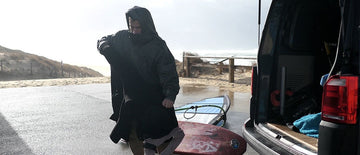When temperatures drop and days get shorter, it's essential to adapt your surfing equipment to take advantage of the waves. Winter sessions often offer exceptional conditions for practicing this sport that moves us, provided you're well prepared.
Which wetsuit for winter?
Choosing the right wetsuit will enable you to continue enjoying the waves in comfort and safety. The ideal wetsuit for winter surfing should offer sufficient thermal insulation, while trying not to develop any annoying properties such as stiffness or lack of comfort.
Here are the winter suit layers and their advantages:
4/3mm: the most popular
Surfers generally agree that 3/2s are too light for cold winter days. You can take my word for it, because this year I decided not to buy a wetsuit over my 3/2. So I surfed in winter with them. I'm not afraid of the cold, and with my booties and balaclava, I was able to cope pretty well, but below 5°C outside, I was really cold: an experience I won't be repeating next year!
The 4/3 is 1mm thicker, and is generally sufficient for surfing in south-west France. For higher regions, it's advisable to switch to the next thickness up.
5/4mm: when it's really cold
Most of these suits include hoods as standard. They are designed for water temperatures of around 10°. Almost a must-have for Breton surfers, these wetsuits are perfect for winter, but will quickly make you too hot in autumn or spring.
6mm and over: for surfing in very cold destinations like Ireland
If you're planning a trip to northern Europe, then take extra care with your equipment, and don't underestimate the coldness of the water: around 6° in winter. It's for these occasions that 6/5mm wetsuits exist, even if they are rare on the market.
Other neoprene accessories to complement
If you go surfing with a thick wetsuit in cold water, you'll quickly notice that without booties, you'll quickly be forced out of the water. As for the hood, it depends on the person and the weather... I tell you all about it here:
Hat and balaclava: depending on the sun
The choice of hood depends above all on the water temperature. In cold winter water, ducking can be very painful on the head. So if you're going to a spot where the bar is difficult to cross, don't hesitate to equip yourself with one.
Another condition to take into account is the amount of sunshine at the time of surfing. If it's very sunny in very cold water, as here in the Landes, you can always surf without a balaclava, as the sun warms your head and is just as effective as a balaclava.
Gloves
Surfing gloves offer enormous comfort. After all, our hands only go in and out of the water, so they are directly affected by the cold. Personally, I never wear them, as I find they reduce your rowing strength, but many surfers do. Worth a try!
Slippers
The essential neoprene accessory, booties keep feet warm in winter. The degree of discomfort depends on the thickness and design of the product. In general, there are now thicker booties that grip the board well, and lighter booties that are lighter and more discreet. There are advantages to every type of model, so it's best to test before you buy.
Which surf poncho for winter?
We couldn't do an article on winter surfing without mentioning our ALL-IN surf ponchos! It's important not to be cold in the water. And so is not being cold when you get out of the water!
Often, when you're well equipped in the water, there's still a risk of curdling on the way home or to your car. That's where we come in.
Terry ponchos, long-sleeved please!
Several materials are used in the design of surf ponchos: microfiber, polyester and cotton. Over 10 years ago, we decided to specialize in cotton. The advantage of cotton is its thickness: it's much warmer than other materials.
Every year, we produce long-sleeved models to meet the needs of winter surfers. Personally, I wear it from October to April, and it's a life-changer! Take a look:
Storm Ponchos: for extreme conditions
Our Storm range is aptly named, designed to cover sportsmen and women in complicated weather conditions, such as storms or extreme cold. In short, a poncho for an ordinary day in Brittany.
Choosing your wax for winter surfing
If you surf in winter with a summer wax, you risk slipping and not enjoying your session. The reverse is also true. There's no need to complicate things: ideal temperatures are often written on wax boxes:
- 15° and under: COLD
- Between 15° and 20°: COOL
- 20° and +: WARM
Other winter must-haves
The search for comfort in winter also includes the after-session. To avoid damaging your feet, you can opt for a waterproof bag to change into and store your wetsuit. Or simply a changing mat.

